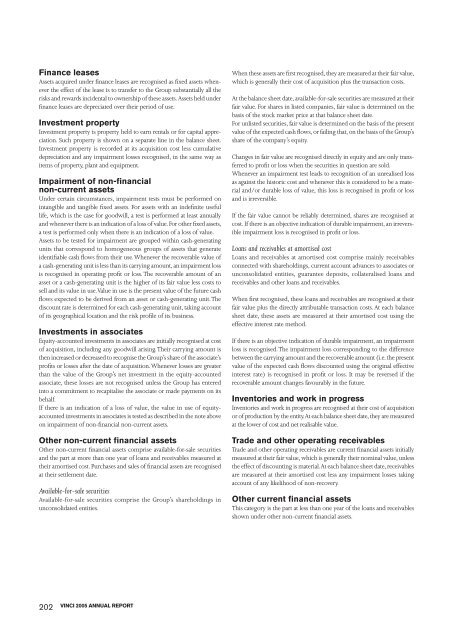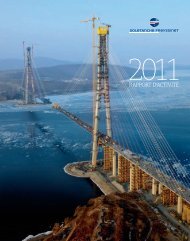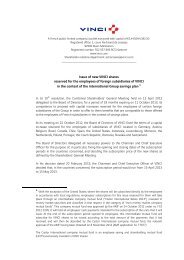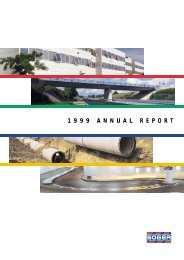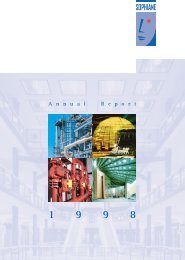VINCI - 2005 annual report
VINCI - 2005 annual report
VINCI - 2005 annual report
You also want an ePaper? Increase the reach of your titles
YUMPU automatically turns print PDFs into web optimized ePapers that Google loves.
Finance leases<br />
Assets acquired under finance leases are recognised as fixed assets whenever<br />
the effect of the lease is to transfer to the Group substantially all the<br />
risks and rewards incidental to ownership of these assets. Assets held under<br />
finance leases are depreciated over their period of use.<br />
Investment property<br />
Investment property is property held to earn rentals or for capital appreciation.<br />
Such property is shown on a separate line in the balance sheet.<br />
Investment property is recorded at its acquisition cost less cumulative<br />
depreciation and any impairment losses recognised, in the same way as<br />
items of property, plant and equipment.<br />
Impairment of non-financial<br />
non-current assets<br />
Under certain circumstances, impairment tests must be performed on<br />
intangible and tangible fixed assets. For assets with an indefinite useful<br />
life, which is the case for goodwill, a test is performed at least <strong>annual</strong>ly<br />
and whenever there is an indication of a loss of value. For other fixed assets,<br />
a test is performed only when there is an indication of a loss of value.<br />
Assets to be tested for impairment are grouped within cash-generating<br />
units that correspond to homogeneous groups of assets that generate<br />
identifiable cash flows from their use. Whenever the recoverable value of<br />
a cash-generating unit is less than its carrying amount, an impairment loss<br />
is recognised in operating profit or loss. The recoverable amount of an<br />
asset or a cash-generating unit is the higher of its fair value less costs to<br />
sell and its value in use. Value in use is the present value of the future cash<br />
flows expected to be derived from an asset or cash-generating unit. The<br />
discount rate is determined for each cash-generating unit, taking account<br />
of its geographical location and the risk profile of its business.<br />
Investments in associates<br />
Equity-accounted investments in associates are initially recognised at cost<br />
of acquisition, including any goodwill arising. Their carrying amount is<br />
then increased or decreased to recognise the Group’s share of the associate’s<br />
profits or losses after the date of acquisition. Whenever losses are greater<br />
than the value of the Group’s net investment in the equity-accounted<br />
associate, these losses are not recognised unless the Group has entered<br />
into a commitment to recapitalise the associate or made payments on its<br />
behalf.<br />
If there is an indication of a loss of value, the value in use of equityaccounted<br />
investments in associates is tested as described in the note above<br />
on impairment of non-financial non-current assets.<br />
Other non-current financial assets<br />
Other non-current financial assets comprise available-for-sale securities<br />
and the part at more than one year of loans and receivables measured at<br />
their amortised cost. Purchases and sales of financial assets are recognised<br />
at their settlement date.<br />
Available-for-sale securities<br />
Available-for-sale securities comprise the Group’s shareholdings in<br />
unconsolidated entities.<br />
202<br />
<strong>VINCI</strong> <strong>2005</strong> ANNUAL REPORT<br />
When these assets are first recognised, they are measured at their fair value,<br />
which is generally their cost of acquisition plus the transaction costs.<br />
At the balance sheet date, available-for-sale securities are measured at their<br />
fair value. For shares in listed companies, fair value is determined on the<br />
basis of the stock market price at that balance sheet date.<br />
For unlisted securities, fair value is determined on the basis of the present<br />
value of the expected cash flows, or failing that, on the basis of the Group’s<br />
share of the company’s equity.<br />
Changes in fair value are recognised directly in equity and are only transferred<br />
to profit or loss when the securities in question are sold.<br />
Whenever an impairment test leads to recognition of an unrealised loss<br />
as against the historic cost and whenever this is considered to be a material<br />
and/or durable loss of value, this loss is recognised in profit or loss<br />
and is irreversible.<br />
If the fair value cannot be reliably determined, shares are recognised at<br />
cost. If there is an objective indication of durable impairment, an irreversible<br />
impairment loss is recognised in profit or loss.<br />
Loans and receivables at amortised cost<br />
Loans and receivables at amortised cost comprise mainly receivables<br />
connected with shareholdings, current account advances to associates or<br />
unconsolidated entities, guarantee deposits, collateralised loans and<br />
receivables and other loans and receivables.<br />
When first recognised, these loans and receivables are recognised at their<br />
fair value plus the directly attributable transaction costs. At each balance<br />
sheet date, these assets are measured at their amortised cost using the<br />
effective interest rate method.<br />
If there is an objective indication of durable impairment, an impairment<br />
loss is recognised. The impairment loss corresponding to the difference<br />
between the carrying amount and the recoverable amount (i.e. the present<br />
value of the expected cash flows discounted using the original effective<br />
interest rate) is recognised in profit or loss. It may be reversed if the<br />
recoverable amount changes favourably in the future.<br />
Inventories and work in progress<br />
Inventories and work in progress are recognised at their cost of acquisition<br />
or of production by the entity. At each balance sheet date, they are measured<br />
at the lower of cost and net realisable value.<br />
Trade and other operating receivables<br />
Trade and other operating receivables are current financial assets initially<br />
measured at their fair value, which is generally their nominal value, unless<br />
the effect of discounting is material. At each balance sheet date, receivables<br />
are measured at their amortised cost less any impairment losses taking<br />
account of any likelihood of non-recovery.<br />
Other current financial assets<br />
This category is the part at less than one year of the loans and receivables<br />
shown under other non-current financial assets.


